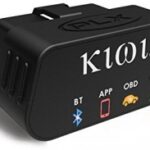It’s often frustrating when you expect seamless data integration between your car’s systems and the infotainment display, especially when it comes to accessing vital OBD2 data. Many users, including myself, have encountered challenges trying to get reliable OBD2 information displayed on their car’s infotainment screen. My experience using the Car Scanner app with an OBDLink MX+ adapter and an MG4 vehicle highlighted some of these common issues and potential workarounds.
While I was initially enthusiastic about monitoring my MG4’s performance data through the OBD2 port and displaying it on my infotainment system via the Car Scanner app, the reality proved to be less straightforward. The combination of what seems to be an inconsistent OBD2 implementation in MG vehicles and the sometimes complex customization within Car Scanner created a less-than-ideal user experience.
Through trial and error, I noted a few observations that might be helpful for others facing similar hurdles when trying to connect OBD2 with their car’s infotainment for data display. These tips are primarily focused on using Car Scanner on Android devices:
Navigating Car Scanner for MG4 OBD2 Issues:
-
Data Value Sensitivity: Be aware that Car Scanner’s performance can be significantly impacted by including problematic data values on your display pages. Some data points may function correctly, others might work intermittently, and some might not work at all or provide incorrect readings for MG4 models. Identifying and removing ‘bad’ values is crucial for page loading speed and overall responsiveness.
-
Page Load Slowdowns: A single malfunctioning or incompatible data value on a dashboard page can dramatically slow down the refresh rate of the entire page. This lag makes real-time monitoring difficult and frustrating.
-
Coexistence of Data Values: Even if two individual data values work quickly and reliably when displayed on separate pages, they might become sluggish when combined on the same page. This is often because they are sourced from different electronic control units (ECUs) within the vehicle, causing communication conflicts or delays.
-
ECU Command Timeout Adjustment: One setting within Car Scanner that frequently improved these performance issues was adjusting the ECU command timeout. Located in Settings > Connection > Advanced, increasing the “Timeout receiving data from ECU command” value from the default 64 to 255 often helped. However, it’s worth noting that this adjustment could potentially worsen performance on some pages, so testing is recommended.
-
Protocol Locking: To potentially reduce connection startup time, you can try fixing the OBD2 protocol to “6) 11 bit 500 kbaud” in the connection settings. This forces the app to use a specific protocol, which might streamline the initial handshake with the car’s OBD2 system.
-
Individual Value Testing with Graphs: Utilize Car Scanner’s graph feature with a single data value to assess its update speed and reliability. Then, test with two values simultaneously to observe how well they function together before building more complex dashboards. This methodical approach helps isolate problematic data points or combinations.
-
Custom ID Management: Saving and restoring custom Parameter IDs (PIDs) within Car Scanner can be inconsistent. In some instances, troubleshooting steps like uninstalling and reinstalling the app (or clearing all app data via Android settings) were necessary, particularly when transferring custom IDs and dashboard configurations between devices. This suggests potential bugs or instability in the app’s data management features.
After several weeks of experimenting and troubleshooting these issues, my initial enthusiasm waned. However, I remain open to revisiting OBD2 data integration with car infotainment systems if Car Scanner introduces significant improvements or if sheer boredom motivates further exploration. Hopefully, these observations can assist other MG4 owners or Car Scanner users in navigating the complexities of OBD2 connectivity and data display on their car’s infotainment screen.
